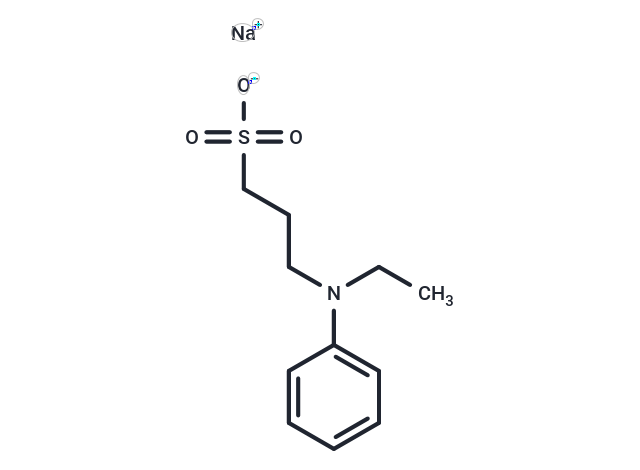Shopping Cart
Remove All Your shopping cart is currently empty
Your shopping cart is currently empty
ALPS (N-Ethyl-N-sulfopropylaniline sodium salt) (N-Ethyl-N-sulfopropylaniline sodium salt) is a bio-chemical reagents/chromogenic reagent.

| Pack Size | Price | USA Warehouse | Global Warehouse | Quantity |
|---|---|---|---|---|
| 50 mg | $29 | In Stock | - | |
| 1 mL x 10 mM (in DMSO) | $39 | In Stock | In Stock |
| Description | ALPS (N-Ethyl-N-sulfopropylaniline sodium salt) (N-Ethyl-N-sulfopropylaniline sodium salt) is a bio-chemical reagents/chromogenic reagent. |
| Cell Research | Instructions
I. Solution preparation 1. Stock solution: Dissolve ALPS in deionized water or an appropriate solvent to prepare a stock solution with a concentration of 10–50 mM. The specific concentration can be adjusted according to the required sensitivity and experimental conditions. 2. Working solution: Dilute the stock solution to the required concentration according to experimental needs, usually 0.1–1 mM. II. Operation steps 1. Enzyme activity determination: (1) Add ALPS to the reaction system containing enzyme and substrate. ALPS reacts with the enzyme or the product of the enzyme reaction, resulting in a color change. The color intensity is proportional to the enzyme activity or analyte concentration. (2) Use a spectrophotometer or microplate reader to measure the absorbance at an appropriate wavelength (usually in the visible light range). 2. Protein quantification: (1) ALPS can be used to quantify protein in solution by reacting with protein to form a colored complex, and the color intensity is proportional to the protein concentration. (2) Follow standard methods similar to other colorimetric quantitative analysis methods (such as Bradford or BCA). 3. Calibration and Control: (1) Control: Set up a blank control or a control without adding reagents to ensure the specificity of the reaction and eliminate interference from other components in the sample. (2) Standard curve: Use samples of known concentrations of analytes (such as enzymes or proteins) to establish a standard curve to relate color intensity to analyte concentration. Precautions: (1) Stability: ALPS should be stored in a cool, dry place and away from light to prevent degradation. (2) pH sensitivity: The activity of ALPS may be affected by the pH of the solution, so the buffer conditions need to be optimized to suit the specific experiment. (3) Safety: Be careful when using ALPS to avoid contact with skin and eyes. Wear appropriate protective equipment such as gloves and safety glasses when handling. |
| Synonyms | N-Ethyl-N-sulfopropylaniline sodium salt |
| Molecular Weight | 265.3 |
| Formula | C11H16NNaO3S |
| Cas No. | 82611-85-6 |
| Smiles | [Na+].CCN(CCCS([O-])(=O)=O)c1ccccc1 |
| Relative Density. | no data available |
| Storage | keep away from direct sunlight | Powder: -20°C for 3 years | In solvent: -80°C for 1 year | Shipping with blue ice/Shipping at ambient temperature. | |||||||||||||||||||||||||||||||||||
| Solubility Information | DMSO: 60 mg/mL (226.16 mM), Sonication is recommended. | |||||||||||||||||||||||||||||||||||
Solution Preparation Table | ||||||||||||||||||||||||||||||||||||
DMSO
| ||||||||||||||||||||||||||||||||||||
| Size | Quantity | Unit Price | Amount | Operation |
|---|

Copyright © 2015-2025 TargetMol Chemicals Inc. All Rights Reserved.